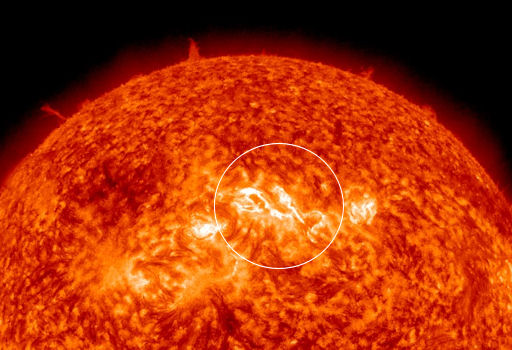
The CME captured by the Solar Dynamics and Heliospheric Observatory (from spaceweather.com)
As the asteroid 2012 DA14 approaches Earth, and is set to pass within 17,000 miles (or less than two Earth diameters) on Friday, at a speed of 17,400 mph, a high probability has also arisen of being struck by a CME (coronal mass ejection) three days earlier. This elicits the question- assuming the worst in each case- of which you’d rather have: a strike by a 15 story wide, 130,000 ton asteroid, or being struck by a CME.
First some background: In the case of the asteroid, NASA reports that this is the closest known approach of an object of this size. (They also add there’s no chance whatever of the thing whacking Earth. Well, assuming it doesn’t get deflected after hitting a geostationary satellite). It was discovered in February 2012 by astronomers at the Observatorio Astronómico de La Sagra; it passed the Earth on Feb. 16th of that year, missing us by a comfortable 2.6 million km (1.6 million miles). The asteroid has a very Earth-like orbit, talking 366 days to orbit the Sun. Its orbit is slightly more elliptical than ours and tilted by about 11° to ours as well. All that’s about to change though: After the encounter this year, the Earth’s gravity will change the orbit of DA14 quite a bit, reducing the period to about 317 days.
The asteroid, with a mass of possibly 10 9 kg would – if it impacts - be about equal to a 20 megaton thermonuclear weapon blast. It obviously would cause considerable damage if it smacked into a city or an island like Barbados – but those odds are even less than our being struck in the first place. The odds are also 3 in 4 that if it did impact it would be an ocean strike, possibly incepting a 20-40 m tidal wave depending on the location, angle of entry, etc.
The CME, meanwhile, was captured by the Solar and Heliospheric Observatory (see graphic) as it shot away from the Sun at 800 km/s. The initial prediction is that the bulk of the ejected mass will sail over the Earth’s north pole. However, spaceweather.com warns there is still a chance of a glancing blow. The former likely means high latitude observers on Earth will see brilliant auroras, but will experience no serious disturbance. A glancing blow possibly means one or more power grids knocked out such as occurred in Quebec in 1989 after a giant solar flare.
In a 2010 episode (‘Magnetic Storms’) of the series ‘The Universe’, the initial sequence featured a March, 2013 CME event which also triggered brilliant auroras, as far south as Cuba, but which also within hours delivered a head on blow to Earth, that knocked out the entire power grid of the U.S. and every single transformer. Such possibilities were discussed in an earlier blog, e.g. http://www.brane-space.blogspot.com/2012/06/cme-that-you-dont-want-to-see.html
The result of the CME hit depicted then was no power across the U.S. No water, since water in your taps requires electricity to pump it, and no fuel either or gasoline, since gas stations also require electricity to effect pumping. For what awaits us, get another gander at those images after superstorm Sandy Struck NY and NJ in November. Long lines, squabbles over position in lines, fights, and even supermarkets going out of business. In other words, no food either! Such a CME would also knock out GPS satellites, and that would wreak even more havoc. Computer networks everywhere would go down, and without electricity anyway – computers would become museum pieces.
The episode projected some 10-15 million dead since the power wouldn’t be able to come back for years, given all the infrastructure would need to be rebuilt, including transformers, power stations, etc. Imagine then a nation with no power to speak of, hundreds of millions without food, limited canned stores – if they have that, no water, and no way to access critical emergency networks or services. The most vulnerable, as in the case of Sandy, would be the elderly, and sick.
The episode went on to further conjecture of an even worse scenario: a CME striking at exactly the time when the Earth’s magnetic poles are reversing. With such a reverse there’d be days or weeks with no magnetic field to protect us from the full brunt of high energy solar particles so the entire planet would be affected with up to 2-3 billion dead as a result of all the power knockouts, the starvation to follow, the mayhem. The ‘End of the World’? Technically no, but many would think it was.
So, on that basis, and given my druthers, I’d always pick the hit from an asteroid like 2012 DA14 rather than a full smackdown from a CME.
Let’s hope neither of them transpires!
1 comment:
Of course, there's always a possibility DA 14 can hit us in the future since orbit of asteroids can always be perturbed. But you're right, I'd worry more about Apophis which - if it impacted - would cause much more damage.
Note btw it is the Earth's gravitational pull which can affect the asteroid orbit, as the Earth has only minimal 'magnetic' effects given its magnetic field is so very weak.
Post a Comment